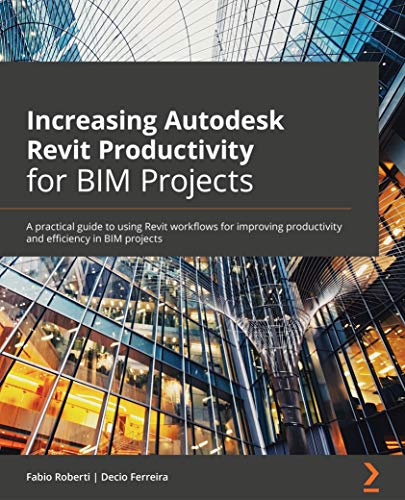Decio Ferreira is a co-author on Increasing Autodesk Revit Productivity for BIM Projects with Fabio Roberti. We got the chance to find out about his author journey and experience of writing with Packt. Find below:
Q: What is/are your specialist tech area(s)?
Decio: My background is Architecture and my passion is still Architecture an Construction. And I can say that everything started based in this: interest in the science of building technology. This included Standards, Methods and Procedures which basically feeds the BIM strategies.
My need of coordinating projects since I´ve started studying Architecture made me research about how to make it easier and on a smarter way where I could somehow control the design. This is when I came across with Revit, back in 2000 (maybe before?).
Along with my progression, I´ve developed workflows and process which will drive the design process by enhancing the project deliverables.
By supporting what I believe as a Digital Strategy by using technology, it helped me to improve what I believe it´s the most important: Collaboration. As technologies develops, all these processes are in constant development, which keeps me always available to embrace new technologies and new workflows and processes.
Through all this process was when my interest in BIM and how the technology could help me to understand and implement all standards that I´ve been working with, including the ISO 1650.
Q: How did you become an author for Packt? Tell us about your journey. What was your motivation for writing this book?
Decio: My friend Fabio was contacted by Packt to write a book about Revit and he asked me if I was interested to write it with him. This was an opportunity to do what I´ve tried to do with other Publishers, which was the opportunity to share my knowledge and expertise not only in Revit but also how to manage and coordinate BIM projects.
The challenge to write the book was thinking on what should be included; we didn´t want to teach how to work with Revit as there are plenty of videos and blogs with these teachings. The idea was focused on sharing the challenges and experiences we came across during the development of a design project. We wanted to share what we think it´s the best practices for several tasks that users use to do on a daily basis to get a better productivity and efficiency in Revit.
Q: What kind of research did you do, and how long did you spend researching before beginning the book?
Decio: The research was basically to understand what is already available in the market and do something practical and based in our experience as Coordinators and Managers. It´s challenging to collect what is really more important as there are still more contents that should be shared.
Q: Did you face any challenges during the writing process? How did you overcome them?
Decio: Writing a book is always challenging. Starting with a blank page is always difficult as there was a lot of topics that we think it´s important to be shared.
To overcome this, I´ve started to write a storyboard to understand the flow of information that we want to be sharing. It helped not only to have a storyboard, but also to understand what is really more important as there was always a limited number of pages.
Q: What’s your take on the technologies discussed in the book? Where do you see these technologies heading in the future?
Decio: Technology pretends to replace everything, but I still believe that is doesn´t. But nowadays, technologies handle a lot of our needs. We need to understand how we can use the software to get a better result without waiting that he will or should be doing everything for me.
Having said this, we all know that there are a lot of technology out there, but it needs to be driven by us. We need to understand how it works and how we can use it in our benefit (our, not as an individual, but as a project).
Revit is one of the most interesting piece of software that I came across; it doesn´t mean it´s perfect, but it means it can be more perfect if we understand how to work with. And this is what we want to show to the readers with our book: teach how the tools can and should be used to get most of the project that all design teams (Architects, Engineers, BIM Teams, Client) are producing.
I believe that software’s will become even more intelligent as we interact with them. They will learn based in user´s experience when and how working with the software. This will give the design teams even more time for the design itself and not for the side tasks as producing the deliverables and managing all the data that can be driven by a BIM model.
Q: Why should readers choose this book over others already on the market? How would you differentiate your book from its competition?
Decio: This is one of the most challenging aspects that we came across when the idea of this project kicked in. What we could do that will make the difference and what could add value in the market? We have a lot of information out there so, preparing a book teaching the basic tools was not going to make the difference. What we decided is that the book should be based in what we have the most: years of experience of working in different companies, building typologies, project stages and so on.
We tried to focus on what and how things should be done properly to get what is required from the client. And because on a BIM world, the client requirements can vary, we briefly explained the main BIM documentation that should be taken in consideration to drive a BIM project.
From the technology, interoperability with different software’s, developing a project template, setting up projects and some more specific tasks, the main target was always improving productivity and efficiency when working with Revit on a BIM project.
Q. What are the key takeaways you want readers to come away from the book with?
Decio: Planning what needs to be delivered. This was the most important thing as it will make users aware of what needs to be done, and what´s the best process and workflow that needs to be followed to get in in a more efficient way.
Q. What advice would you give to readers learning tech? Do you have any top tips?
Decio: Starting to learn and use technology is never easy. So, keep it simple. If possible, find someone with experience to drive you how we should be driving the software and not only describing the features as they are presented and developed by the software houses.
Next step is to start modelling and developing a small project, and a simple one. It will allow you to be focusing on the tools and understanding what needs to be done in a proper way.
A template is a must: this doesn´t look right. This will force you to understand some important things.
Always online is key. Go and find workshops, events, training videos, opinions to understand different ways of doing things; LinkedIn, Twitter, blogs and even events like Autodesk University or Built (DBEI – Digital Built Environment Institute). Make you part of this and you will find the Master users you should be following.
Q. Do you have a blog that readers can follow?
Decio: In the past I used to collaborate on a blog with my friend Fernando Oliveira, but this project is now “on hold”:
http://revit-pt.blogspot.com/
For the last 2 months I have started to plan to have a blog and even a YouTube Chanel to re-start the process of sharing information with all my friends, colleagues, students and followers. Again, the main challenge is to understand what should be done to make the difference and not being “another blog” or “another channel”. A 5 minutes videos should be followed with small tips and tricks.
If you have any idea that you want to share about how it should be presented, please feel free to reach me
Q. Can you share any blogs, websites and forums to help readers gain a holistic view of the tech they are learning?
Decio: Nowadays, there are a lot of information available about Revit, Technology and BIM. A simple search will show plenty of links about this content.
But I´ll leave some here if you want to have a look:
1. Autodesk University:
https://www.autodesk.com/autodesk-university/
One of the most interesting events I´ve been where you can learn and have access to loads of learning classes.
2. BUILT
https://www.dbei.org/
Another interesting event and where you can learn and have access to learning classes.
3. AUGI
https://www.augi.com/
One of the biggest CAD & BIM user group.
4. AEC Magazine:
https://aecmag.com/
Keeps you up to date about the last technology updates and trends
Q. How would you describe your author journey with Packt? Would you recommend Packt to aspiring authors?
Decio: Packt is supported by a team always available to support the authors. At any time, they will give support, guidance and all information needed to help and make it happen. I´m very grateful not only with the contact points, but also all the back-office team which they were commenting, formatting and conducting all tasks needed to make it happen.
I do recommend Packt as a publisher if you are planning to become an author.
Q. Do you belong to any tech community groups?
Decio: Yes, I´m a very active user of community groups. Some of these groups are more technical, about specific tools, others more theoretical which is related with the many tech ISO 19650, for example. I´m one of the Administrators of one of the biggest Facebook groups about Revit. By following my social media, it´s possible to have an overview of how many groups I´m subscribing.
Q. What are your favorite tech journals? How do you keep yourself up to date on tech?
Decio: One of my favourites is the AEC Magazine: https://aecmag.com/
To keep me updated I use to participate in events like Autodesk University and BUILT when is possible, or even smaller, but not less important and interesting like BIM Show Live, and others. The most important thing is to be always in contact with the community which they are always available to share with us their expertise and problems which they will be key to make us being our one problem solvers.
Q. How did you organize, plan, and prioritize your work and write the book?
Decio: Writing a book is not an easy task. It needs organization, prioritization and for sure a plan.
With Fabio was quite easy to do all together as we know each other, we have pretty much the same experience and we worked together in the past.
We did some calls to define what should be included and how we should be proceeding with the content production.
After the first paragraphs, your ideas started to be aligned and everything became easier.
Q. What is that one writing tip that you found most crucial and would like to share with aspiring authors?
Decio: Storyboard your ideas. It will guide your thoughts, research and ideas. After breaking down the big chapters into small sections.
This helped me a lot to organize my ideas.
You can find Decio’s book on Amazon by following this link: Please click here









